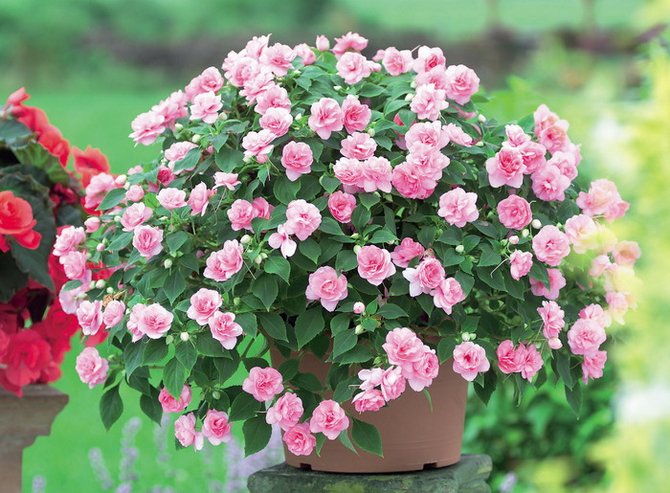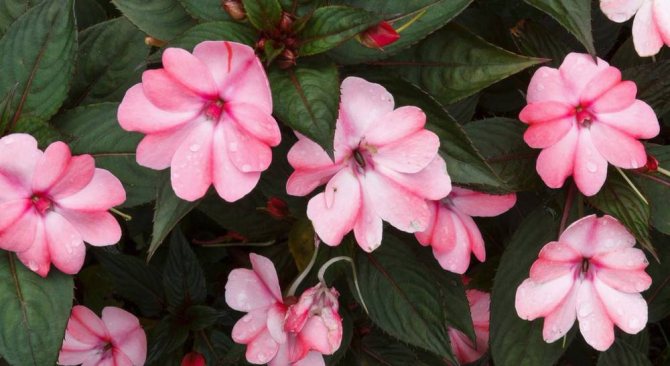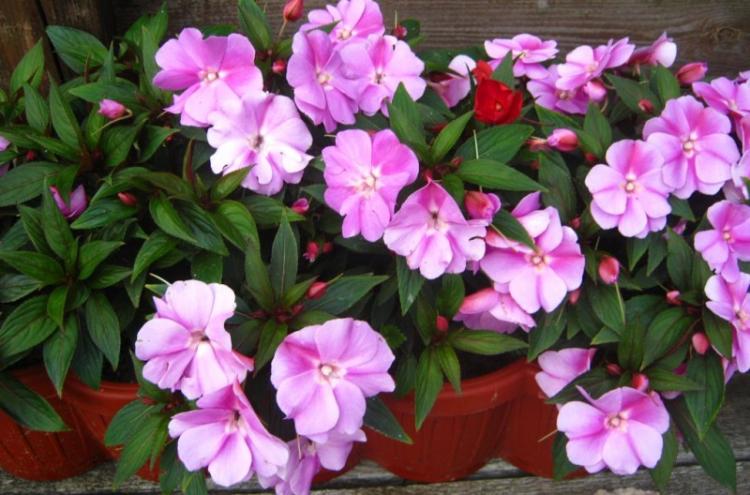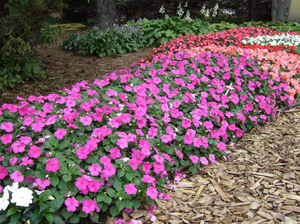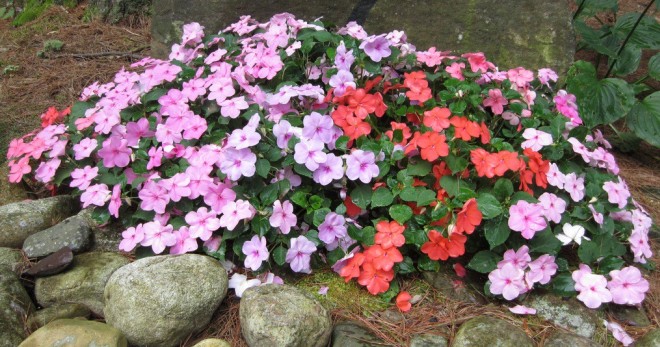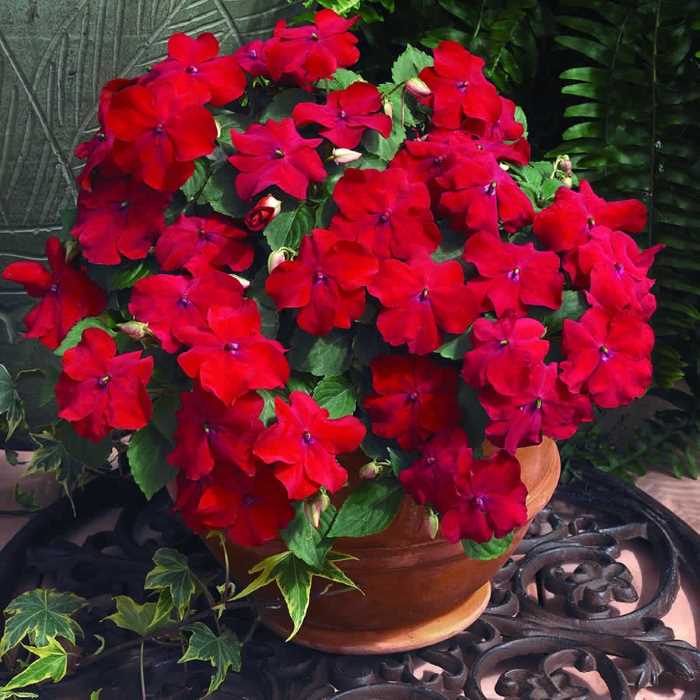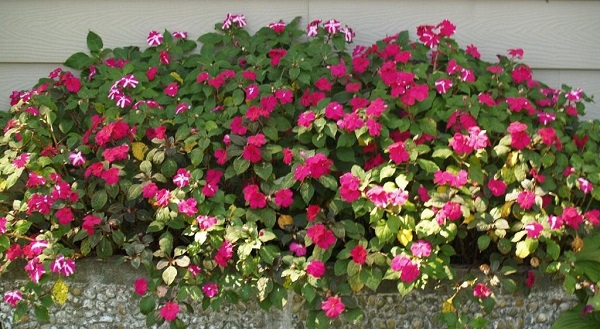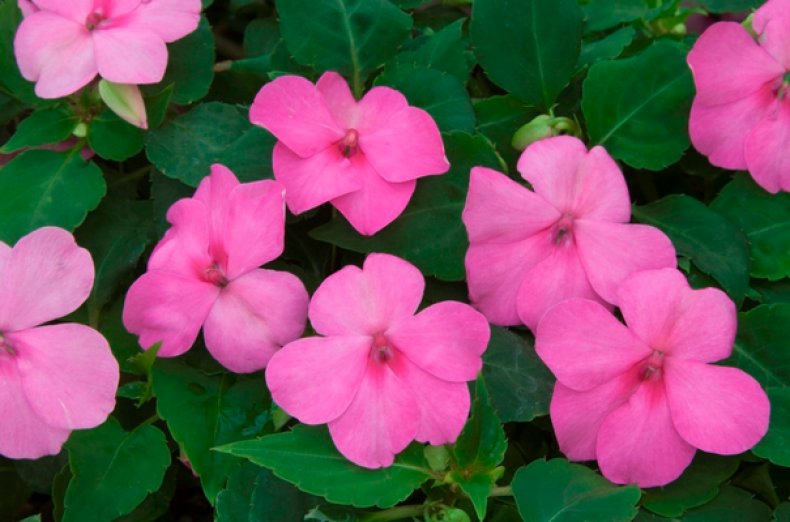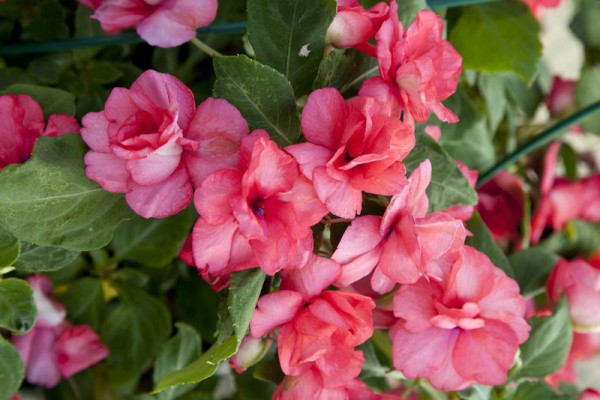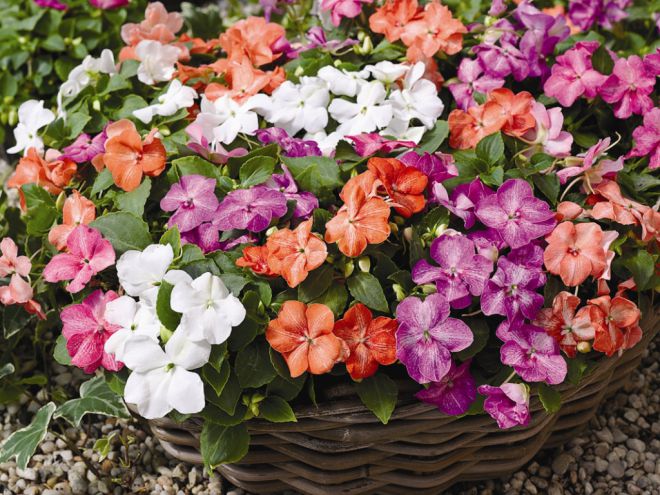Garden balsam: planting and care in the open field
In early or mid-May, when the frosts are over, Balsam can be planted in open ground or in pots and pots for outdoor decoration.
It is important to remember that this flower is photophilous, but hot weather and bright sun all day long can weaken the plant, so the best option for Balzamin is partial shade. It is better to place pots and pots under awnings, canopies, and in the garden they should be planted along fences, under the crown of trees, shrubs, next to tall flowers, or on the side of the site where the sun does not shine all day
The soil
The grown branchy bushes are no longer as whimsical to the ground as young shoots. The soil should be fertile enough, non-acidic, loose. The holes for planting seedlings are made according to the size of an earthen coma in glasses so as not to deepen the root collar. At the bottom of the holes, you can pour a little dry vermicompost. If a lump of earth taken out of a glass is all stitched with white roots, it means that the bush has developed correctly and will be well accepted in a new place. After planting, the bushes need to be watered well, the soil around should be mulched. Mulch will protect the soil from drying out, maintain good aeration of the roots, and retard the growth of weeds.
Advice - to determine the acidity of the soil, you can boil a few currant leaves with boiling water and insist on them. If, when adding a little earth to the infusion, it acquires a reddish color, then the soil is acidic, the blue solution indicates that the soil is slightly acidic, the green solution is the neutral soil.
Watering
Balsam is a moisture-loving plant; from a lack of moisture, the leaves grow dull, curl, the flowers crumble, but an excess of moisture in the soil can lead to fungal diseases. Therefore, daily watering is needed only on hot summer days. The soil should be moist to a depth of 30-40 cm, no more. Potted flowers are watered in trays. For irrigation, it is advisable to use rainwater or settled water warmed in the sun.
Top dressing
Abundant incessant flowering for a long time requires regular fertilization of the soil. Top dressing should be applied every 2-3 weeks.
It is important to remember that nitrogen fertilizers stimulate the growth of the green mass of the plant, potassium improves the decorative properties of flowers, phosphorus strengthens the root system. By the appearance of the bushes, you can determine what the flowers are missing
As practice shows, complex fertilizers support the plant well, the main thing is not to abuse nitrogen fertilizing, otherwise there will be more leaves than flowers.
Advice - in order for Balsam to bloom luxuriantly, abundantly, for a long time, it is recommended to regularly pick off old flowers and tops of the stems. This will enhance the branching of the bush and the formation of a large number of peduncles.
Breeding Balzamin is a simple and not laborious process. By following these recommendations correctly and in a timely manner, the cultivation of these flowers will become fun and interesting for you. Balsam is an unpretentious, sympathetic and grateful flower. It can be grown as annuals and perennials, at home and outdoors. It does not have a dormant period, so it can bloom for a whole year. And there is only one drawback - an incredible number of varieties and colors, eyes run wide, it is difficult to make a choice.
marked,
Your opinion is very important to us. Please rate the article: No ratings yet
Please rate
Categories
- Indoor plants Ampelny
- Bromeliads
- Decorative deciduous
- Trees and shrubs
- Orchids
- Succulents
- Blooming
Garden plants
- Ornamental trees and bushes
Garden flowers
- Perennial
Annuals
Useful information:
- How to grow chestnuts from walnuts at home
- Clematis: planting and care in the open field, for beginners
- How to grow pomegranate from seed at home
- Decembrist flower: care and reproduction
- How to grow a lemon from a seed at home with fruits: step by step
- Lilies: planting and care in the open field
- Garden azalea: planting and care in the open field
- Bacopa: care and cultivation
- Buttercup garden: planting and care in the open field
- Weigela: planting and care in the open field
Recent comments
- Lyudmila on How to grow a lemon from a seed at home with fruits: step by step
- Tatiana on Tillandsia Anita: home care
- LOVE on Tulips: planting and care in the open field
Reproduction and transplantation of New Guinea balsam at home
The plant is propagated in two ways: vegetative (cuttings) and generative (seeds). Most growers prefer vegetative propagation.
Cuttings
The best time for grafting is March. At this time, a new round of vegetation begins. March cuttings will bloom this year
Unlike the seed path, propagation by cuttings allows you to preserve the varietal characteristics of the mother plant, which is important for the reproduction of rare hybrids. Propagation of balsam by cuttings consists of several stages:
- An apical shoot with three internodes is cut from an adult plant. The lower leaves are removed. On the shoot intended for the cutting, there should be no buds or inflorescences.
- The cutting is rooted in a container with water or with a wet mixture of peat (1/4), vermiculite (1/4) and perlite (1/2). The water is periodically replaced with fresh water.
Cuttings are left in a warm room with bright, diffused light.
To speed up the rooting process, the container is covered with a film or a transparent cap.
Cuttings placed under the film need daily ventilation. Cuttings that take root in the soil need to be sprayed additionally on a daily basis.
In water, balsam takes root in 10-14 days, in soil - after a week. After rooting, the film is removed and the cuttings are left to strengthen for 2-3 weeks. They are then planted as mature plants.
Seeds
The advantage of seed propagation is the large number of new specimens. But this method also has disadvantages. First, the seeds do not retain varietal characteristics. Secondly, they do not have very good germination.
You can remove a plant from seeds as follows:
- Balsam seeds are pre-soaked in warm water.
- A couple of hours after soaking, the seeds are mixed with sand and placed in a container with wet peat.
The container is covered with foil and left in a warm, bright place.
Seedlings require daily ventilation and moisture. Instead of watering, the soil is sprayed with a spray bottle so as not to wash out the seeds.
Seedlings appear 2-3 weeks after sowing. As soon as this happens, the film is removed.
When the sprouts reach 5 cm, they are transplanted into the usual soil for balsam.
Transfer and landing
The flower has a very developed root system, so the transplant is carried out every year. It is advisable to carry out the procedure in the spring, before the period of budding and flowering. A flower transplant involves the following steps:
- The plant is carefully removed from the old pot and freed from the old soil.
- The roots are carefully examined for rot. If it is, the affected areas are cut off and treated with a fungicide solution.
A quarter of the new pot is filled with drainage (expanded clay, pebbles, broken brick).
A little soil is poured onto the drainage layer. A flower is placed on top and its roots are straightened.
The voids of the pot are filled with the remaining soil. The soil is slightly trampled and moistened.
The first planting is no different from the flower transplant procedure. For young plants, pots are selected with a diameter of no more than 10 cm.The plant is comfortable in nutritious and loose soil. Most often, balsams are planted in a universal soil with the addition of vermiculite.
Diseases and pests
All plants can undergo some kind of disease or pest attack. And balsam is no exception. In order not to destroy the plant, you need to quickly understand what it is infected with, and immediately begin to act.
-
Leaves are falling - what to do? This can be caused by cool air or poor lighting.
- Move the pot to a warmer, lighter spot. The problem should be fixed.
- If not, check the soil for dryness. Maybe you water the flower irregularly.
- Why do the leaves curl? This is a sign of tick damage to the plant. Remove the infected parts, and treat the remaining parts with a disinfectant solution.
- The leaves turn yellow. Yellowing signals a lack of moisture. Spray the leaves often, but be careful not to get on the flowers themselves.
-
Buds are falling - what is the reason?
- This happens when watering is too frequent or infrequent. Adjust its frequency.
- Another reason for the dropping of buds can be adaptation to new living conditions.
- Leaves dry - how to fight? This is a reaction to a lack of moisture. Try increasing your watering frequency.
- The stems are too elongated. This happens when there is not enough light for the plant, and the air, on the contrary, is too warm. To avoid this trouble, move the flower to a lighter and cooler place.
-
Balsam blooms inactively.
- Weak flowering indicates a lack of light and nutrients.
- Another root of the problem is hypothermia. Increase the dose of light and fertilizer - the plants will start to delight you with their flowers again.
- Are the leaves withering and falling - the reason? This happens if the plant has been attacked by root rot due to over-watering. Due to the constantly moist soil, the roots began to rot. To get rid of this, transplant the flowers into a new soil, while rinsing the roots, and then adjust the frequency and abundance of watering. It is best to do this when the soil is completely dry.
-
A spider mite attacked. This ailment is characterized by the appearance of yellow spots on the leaves. Over time, the pigmentation will increase and cover the entire leaf plate.
- To prevent the tick from spreading, remove the damaged area.
- If the specks are still small, you can treat the leaves with soapy water.
- To avoid reappearance of this pest, spray the plants so that the air around is not dry.
- The appearance of a whitefly on a flower. This insect can be recognized by the yellowing of the leaves and sticky secretions on them, both on the inside and on the back of the leaf. For prevention and treatment, treat balsam with products based on potassium soap.
- When thrips attacks. This disease can be recognized by the deformation of young leaves, the appearance of spots on the flowers and brown color along the edges of the petals. To control thrips, you can only remove the affected flowers.
The types and varieties of Balsamin cultivated in at home and in the garden... On our website, we talked about this beautiful flower in a number of articles:
- New Guinean: features of growing an African guest.
- Tom Samb: pink touch-me-not on the windowsill, care and illness.
- Iron-bearing: description and medicinal properties of a wild plant.
- Ferruginous: growing rules, diseases encountered.
- Ampelny: planting and caring for plants in your home.
- Wild: how to grow on a personal plot?
- Roly wet: growing and common diseases of a perennial plant.
- Garden: flower for open ground, planting and care.
- Terry: features of cultivation and care.
So, we told the main thing about Waller's balsam, now you know how behind him look after and how to solve possible problems.
What to do when a flower withers
Every grower should know what to do if New Guinea balsam withers. Very often wilting is associated with improper care. Main reasons:
- Low humidity and high room temperature. To eliminate the flower, spray it with a spray bottle and place the pot in a bowl of water for a few minutes.
- Lack of light. Move the flowerpot to another more illuminated place or install a phytolamp.
- Small or large amount of dressings. Fertilizer should be applied 2 times a month.
- Wrong flowerpot size. Balsam needs a small pot for the root to fill it.
Timely implementation of the basic rules for caring for the plant will allow you to grow a healthy balsam at home, which will decorate the room with its flowers for a very long period.
How to plant balsam seeds?
If you want to get your own healthy seedlings, then you must first study the advice of experienced gardeners on how to breed balsam at home, growing from seeds, when to plant a beautiful flower in unprotected soil. It is not necessary to purchase ready-made soil in stores, the nutrient substrate is easy to prepare yourself. You need to mix 1 part vermiculite, 1 part sand, 1 part leafy soil and 2 parts low-lying peat.
Planting balsam seeds for seedlings:
- We pickle the balsam seeds in a solution of potassium permanganate for 10 minutes.
- Next, we soak the material in warm water for a day.
- It is advisable to choose a sowing container with a height of 8 cm.
- In the bottom of the box we make holes for the liquid to drain.
- At the bottom we lay expanded clay drainage up to 2 cm high.
- Pour soil into the container.
- For disinfection, the soil can be calcined in the oven a day before sowing or treated with "Fitosporin".
- Soaked seeds should be planted in the ground without deepening, gently pressing them to the surface with the tip of a toothpick.
- The substrate is moistened using a spray bottle and covered with a bag until sprouting, leaving a gap for air to enter.
Balsam - growing from seeds in peat tablets
When working with a small amount of planting material, it is more convenient to grow balsam in peat tablets. The sprouts in this case are strong, less dirt is formed, and the container is easy to place on the windowsill. The tablets are moistened with water until they swell. Then, from above, without sprinkling it with earth, we plant seeds one at a time, gently pressing them to the ground. It is advisable to cover the container with foil and place it in a warm and bright place, but not in direct sunlight.

How many days does balsam rise?
Under optimal conditions, balsam shoots appear in a week. Often the sprouts hatch uncommonly, but you should not despair. Planting material in stores is sold of different quality and shelf life. You need to wait up to 2 weeks, during which time all living change will germinate. It is imperative that after the emergence of sprouts, we remove the lid or bag and transfer the container to a bright place, we grow at a temperature in the range of 17-20 ° C.

Why doesn't balsam rise?
Often, among amateur flower growers, young shoots die or there is a poor percentage of healthy seedlings. This occurs among inexperienced beginners who do not observe the temperature regime, water the balsam incorrectly, cultivate from seeds, when they plant, they do not meet the deadlines. There are several reasons that significantly affect the pecking of planting material, some depend on the gardener himself, and others on weather factors.
Why balsam seeds do not sprout:
- The soil is poorly warmed up - the optimum temperature for the development of balsam is from 18 ° C.
- If a box with crops is installed under the scorching sun and the soil warms up above 25 ° C, then the seedlings will die in the embryos.
- The seeds were not soaked during planting.
- Too dense soil structure - choose a loose and soft soil for this crop when growing from seeds.
- Using expired seeds - for balsam, the shelf life is 7 years.
- When grown in an acidic environment, germination decreases, we prepare the soil for seedlings with a neutral reaction (approximately 6.2-6.5 pH).
Balsam seedlings stretched out, what should I do?
Often there is an unpleasant stretching of the shoots, which makes it difficult to leave, picking, and leads to lodging of plants on the soil. The reason lies in the early sowing of seeds, poor lighting in early spring, and elevated indoor temperatures. If the balsam seedlings are strongly elongated, then the seedlings can be saved by adding soil to the level of the cotyledon leaves. When grown in deep containers or boxes, it is more convenient to do this, otherwise you will have to build up the sides to the desired height using waterproof material.
Balsam pick from seeds
Timely picking of balsam is made no earlier than two true leaves of a young plant will fully develop. Before this operation, we water the soil with seedlings to reduce the risk of injury to the roots and thin stem. Use a spoon or a spatula to pry on the seedling and take it out of the common box. The sprouts should be deepened up to the cotyledon leaves. A pick can be done in plastic bags, glasses, cassettes. We make a hole in advance in an individual container for draining excess water.

Options for planting street balsam in a flower bed in the garden
Balsams are used quite often and with great success in landscaping the local area, as well as in the creation of landscaped gardens. An attractive plant can be planted even in the shade and partial shade if it is possible to maintain high soil moisture levels.
As a rule, ornamental garden culture is used when creating mixborders, as well as decorating a flower bed or border. Due to the variety of shades and colors, it is possible to create very original patterns with contrasting or smooth transitions. Also, very often, many varieties are planted in garden pots, decorative containers, as well as hanging baskets in order to decorate a veranda, balcony or terrace.
Popular types
Balsam (how to grow this crop, will be described in detail later) is a representative of annual plants of the group of shrubs. Its height at home can vary from 25 to 50 centimeters. A distinctive feature is that in the process of growth, characteristic droplets are formed on large leaves, characteristic only of this family of shrubs.
During the flowering period, large buds appear on the shoots. In shrubs that grow in the wild, they are purple or pale pink. But in indoor plants, shades of flowers can be very different. Today, you can find a huge number of hybrids on sale with simple and double flowers of any color, except for yellow and blue. The flowering of balsam (how to grow a flower with minimal physical costs, you will learn later) is quite long. It begins in mid-May and continues right up to the onset of the first frost.
Breeders have bred many varieties of shrubs, which differ in characteristics and decorative properties. But the following varieties are considered the most popular:
- Impatient Waller. Possesses good frost resistance, therefore it is excellent for growing in regions with harsh climatic conditions. However, the shape of the bush is not too lush, as well as rather poor flowering.
- Balfour. It differs from its counterparts in excellent decorativeness. The height of the bushes can be up to one meter. The flowers are very large and can be purple or pink in color. Due to its lush crown, it is often used to create hedges and plantings.
- Iron-bone.It is a New Guinean hybrid with large erect shoots. Has gained wide popularity in landscape design. With proper maintenance, it can grow up to two meters. Flowering is not only long-lasting, but also very lush. Among the disadvantages can be identified the problematic care.
Having considered the most popular varieties, you can talk about how to properly grow balsam. There is nothing difficult in this, but some rules must be followed. If you do not adhere to the technology, then the plant will take root for a long time in the open field, and flowering will begin much later.
Timing and technology of planting balsam in the garden
The best way is the seedling method of growing balsam as an ornamental horticultural crop. A day before transplanting the seedling material to open ground flower beds, it is necessary to thoroughly moisten the soil under the plant, after which the root system is carefully, without destroying the earthen coma, removed from the seedling container.
All dry and rotten roots are cut with a sharp and clean knife, after which the cut sites are disinfected with wood ash or activated carbon powder. When planting, you need to carefully monitor the location of the root collar, which should be above the ground. During the first few days, the planted flower bushes are necessarily shaded. Irrigation measures at the stage of survival of the root system should be abundant enough, with settled water, until the earthen coma is completely wetted.
Garden balsams belong to the category of moisture-loving plants
Buying seeds
One of the important conditions for the successful cultivation of balsam is quality seeds.
When choosing them, it is important emphasize on following aspects
Shelf life. Balsam seeds remain viable for 7 to 8 years. However, it is recommended to give preference to fresh seeds to guarantee their germination.
When choosing, studying the information on the bag, it is important to pay attention not to the period of sale of seeds, but to the period of their collection, by which you can determine their freshness
Annual or perennial. Balsamin has both annual and perennial varieties. You can decorate the balcony with annual plant varieties. For indoor cultivation, it is better to give preference to perennial varieties so that they delight the eye with luxurious flowering for more than one year.
Variety or mix
When buying seeds, it is important to know that a mixture of varieties makes it possible to grow flowers of unexpected shades for a grower, but it can also disappoint by the lack of varietal characteristics in the grown balsams. The classic variety guarantees the desired shape and color range of flowers
Reliable manufacturer. Experienced growers advise buying seeds only from large seed companies and reliable, time-tested stores.
Description
New Guinea hybrids hit the mass market in 1972. They were obtained by crossing the Indonesian Hocker variety with other varieties. Initially, the flower grew in hot countries. It was brought from the subtropics and tropics of Africa, Asia and America.
Balsam is a bush-shaped plant with many smooth stems. The root system of an indoor flower is strong, so it grows well in comfortable conditions. The leaves reach a maximum length of 13 cm and can be of various colors: from dark green to burgundy. The leaf itself is oval or lanceolate, bordered with denticles along the edges.
Flowers emerge from the leaf axils. Usually they are painted pink or red, have a pleasant terry surface, measure 5–7 cm. There are also varieties of shades of apricot, salmon, fuchsia. Depending on the variety, they are one-color or two-color with patterns. When the flowering period ends, seed pods appear in place of the buds, which burst at the slightest touch and scatter the seeds around them.Among the variety of species of Guinean balsam stand out undersized (up to 20 cm high) and high (from 50 cm to 1 meter).


